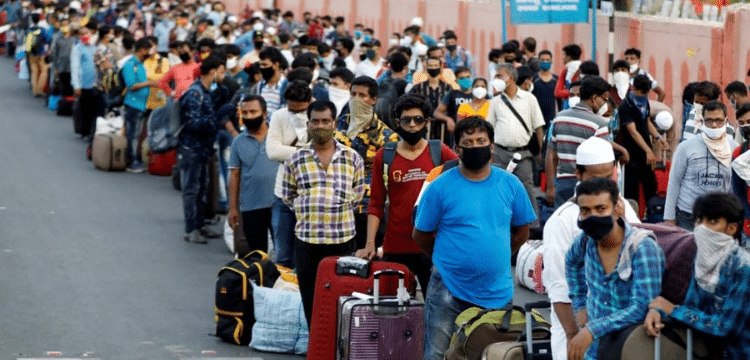[vc_row][vc_column][vc_column_text dp_text_size=”size-4″]The COVID-19 epidemic halted international mobility, with migrant labourers bearing the brunt of the consequences. However, Bangladeshi labourers are doing remarkably well.
Abul Basar has been in Saudi Arabia for the past 14 years. He tried his luck as a migrant worker in the oil-rich desert state after failing to find a suitable job in Bangladesh, first in Riyadh and then in Jeddah, to support his family in Bangladesh. He most recently worked as a plumber at a water treatment plant in the province of Al Qasim. Then the coronavirus struck.
Basar is one of around 260 million migrants worldwide whose labour leads to a significant shift of capital to lower-income regions. He sends home 90% of his earnings — 2,000 Saudi riyals ($533, €498) every month — to support his four-person family.
South, East, and Southeast Asia account for more than half of all migrant workers. They account up roughly 20% of the workforce in Western, Northern, and Southern Europe, as well as the United States. It is roughly 41% in the Gulf states.
Europe, the United States, and the Gulf States are the most important destinations for migrant workers and the source of the majority of remittances (shown in dark blue on the map).
Also Read: Billions in Danger Due to 2-Degree Limit Overshoot
Remittances: The Economic Stabilizer
Migrant workers’ remittances do more than merely support their family. They also help to keep entire national economies stable. Remittances make for more than 10% of the national GDP in Zimbabwe, Georgia, Nicaragua, and Senegal. More than 20% in El Salvador, Gambia, Jamaica, and Nepal, and around 30% in Kyrgyzstan and Tajikistan.
Remittances aid North and Sub-Saharan Africa, South and Southeast Asia, and Central America in particular.
However, with the advent of the COVID-19 pandemic, this paradigm appeared to be jeopardised. Lockouts and job losses threatened to suffocate the continuous flow of capital transfers. Experts at the World Bank estimated in April 2020 that migrants will send $129 billion less home in the first year of the epidemic, a 20% decrease.
In truth, payments immediately recovered after a brief, steep decline. At the start of the pandemic, currencies in key emerging economies including as Brazil, South Africa, and Turkey dropped substantially, while remittances from dollar and euro economies increased in value. Despite losing their employment, many migrant workers are likely to have used their resources to support their relatives back home.
“I usually send around 500,000 BDT ($5,775; €5,450) to my family every year,” Abul Basar explained.
However, this has changed since the pandemic. He attempted to transfer more money to his family during the last two years.
“My father was infected with COVID-19 in 2021, and his treatment cost more than 100,000 BDT.” I compromised my savings that year and sent more than 600,000 BDT to my family to cover their unexpected expenses.”
The ‘Employment Gap’ With the Local Population
As a result, the pandemic increased the financial pressure and resulted in substantial job cuts for migrant workers. Seasonal and migratory workers, in particular, who had little legal protection, were laid off rapidly. In many countries, the local population’s unemployment rate has also risen. However, layoffs disproportionately impacted migrant employees. In some countries with a high seasonal labour force, such as Hungary, Spain, and Italy, migrant workers were 50% more likely to be unemployed than native workers.
According to the International Labour Organisation, a UN agency, migrant workers are more likely to be unemployed than the native population since they frequently work in risky, low-wage sectors. Catering, tourism, culture, retail, and construction are among the industries hardest damaged by the pandemic.
True unemployment levels are likely to be considerably higher when migrants who fled the nation owing to job losses are not reflected in the statistics.
When the pandemic struck, India alone had 6.1 million stranded workers who had to be brought home on charter flights. Hundreds of thousands left Thailand, Nepal, Malaysia, and Sri Lanka, many of them owing to layoffs. According to the ILO, the situation in South America and Africa was similar. Migrant labourers in the Arab Gulf states were particularly hard hit.
It’s unclear when these folks will be permitted to return to the nations where they worked. While at the start of the pandemic, nearly every country in the globe closed its borders to discourage travel, migration laws have changed.
Entry has also become more difficult due to vaccination requirements. Not only do the United States, the European Union, South Korea, the United Arab Emirates, and particularly Saudi Arabia demand confirmed COVID-19 vaccination. For a time, they rejected several Chinese-made vaccines, judging them insufficient. However, these were commonly used in South and Southeast Asia.
The ‘Saudization’ of Saudi Arabia
The Gulf’s restrictive policies, in particular, might be attributed to the so-called Saudization of the economy. The government policy, which has been in effect since 2018, compels enterprises to “increase the proportion of Saudi nationals in their workforce,” with penalties for “firms with low percentages of Saudi workers and’redundant’ foreign workers,” according to a research conducted by the human rights organisation FairSquare Project. The Saudi health industry, for example, must reach a local employment target of 30% to 60%.
“Firms above the quota are granted benefits, while those below face restrictions on expat hiring,” according to a study conducted by Harvard University’s Centre for International Development.
Bangladesh has smashed the record for the greatest remittance inflows in its history three years in a row. Official projections show that workers will send back more than $22 billion in 2021.
According to Dr. Zahid Hussain, former senior economist of the World Bank’s Dhaka office, there are two unique elements driving Bangladesh’s recent record remittance inflows. First, it is likely that migrant workers transmitted more remittances through unofficial routes than through legal methods.
“Because unofficial channels were completely disrupted during the pandemic, they were forced to choose the latter,” Hussain explained.
Many others moved their savings to Bangladesh out of fear of losing their jobs.
“Some may have returned to the country with all of their savings because they did not have a job,” he explained. “This may help to boost the remittance inflows of the last two years.”[/vc_column_text][/vc_column][/vc_row]











